Influence of Meteorological Parameters on Indoor Radon Concentration Levels in the Aksu School
Abstract
1. Introduction
2. Materials and Methods
2.1. Study Area
2.2. Indoor Radon Measurements
- Q—fresh air flow through the room, m3/h;
- V—volume of the room, m3;
- D—occupancy density, m2 person;
- h—height, m.
- Q—fresh air flow through the room, m3/h;
- V—volume of the room, m3.
2.3. Measurement of Meteorological Quantities
- Measurement of the maximum temperature—TM-1-1 and TM-1-2 thermometer; TM-1 meteorological glass thermometers are designed to measure the maximum temperature over a certain period of time. The measurement range of the TM-1-1 is from −35 to 50 °C, and for TM-1-2 from −20 to +70 °C. The limit of permissible error of the thermometers after the introduction of corrections is not more than ±0.2 °C. The manufacturer is JSC “Thermopribor”, Klin, Moscow region, Volokolamsk highway, 44.
- Measurement of the minimum temperature—thermometer TM-2-3; meteorological glass TM-2 thermometers (hereinafter referred to as the thermometers) are designed to measure the minimum air temperature over a certain period of time. The measurement range of the TM-2-3 is from −50 to 40 °C, and the limit of permissible error of the thermometers after the introduction of corrections is not more than 0.5 °C. The manufacturer is JSC “Thermopribor”, Klin, Moscow region, Volokolamsk highway, 44.
- Measuring soil temperature—thermometer TM-3-1; meteorological glass TM-3 thermometers (hereinafter referred to as the thermometer) are designed to measure the temperature of the soil’s surface. The measurement range of the TM-2-3 is from −35 to 60 °C, and the limit of permissible error of the thermometers after the introduction of corrections is no more than 0.2 °C. The manufacturer is JSC “Thermopribor”, Klin, Moscow region, Volokolamsk highway, 44.
- TM10-1 meteorological glass thermometers (hereinafter referred to as the thermometers) are designed to measure the temperature of deep soil layers and measure the temperature of the surface layer of water in reservoirs. The measurement range of the TM10-1 is from −20 to 30 °C, and the limit of permissible error of the thermometers after the introduction of corrections is no more than 0.1 °C. The manufacturer is JSC “Thermopribor”, Klin, Moscow region, Volokolamsk highway, 44.
- TM4 meteorological glass thermometers (hereinafter referred to as the thermometers) are designed to determine the temperature and humidity of the air. They are used in pairs in station psychrometers. The measuring range of the TM4-2 is from −25 to +50 °C, and the limit of permissible error of the thermometers after the introduction of corrections is not more than 0.1 °C. The manufacturer is JSC “Thermopribor”, Klin, Moscow region, Volokolamsk highway, 44 [32].
- Humidity and temperature sensor HMP155—humidity and temperature measurement, humidity measurement range from 0 to 100%, temperature from 80 to +60 °C. The error is ±0.6% (0–40%), ±1.0% (40–10%) [33].
- The M63M-1 anemorumbometer is designed for remote measurement of instantaneous, maximum, and average wind speeds and directions. Measurement ranges: instantaneous wind speed, m/s from 1.5 to 60; maximum wind speed, m/s from 3 to 60; average wind speed, m/s from 1.2 to 40; and wind direction, degrees from 0 to 360. The averaging periods of the average wind speed are 2 and 10 min. The main measurement error is no more than, when measuring wind speeds, m/s ± (0.5 + 0.05 V), where V is the measured wind speed; and when measuring wind direction, degrees ± 10. The manufacturer is JSC Safonovsky Plant Gidrometpribor, Russia, 215500, Safonovo, Smolensk region [34].
- For the BRS-1M-1 barometer, the barometer is designed to operate under conditions established for the performance of UHL category 4.2 according to GOST 15150-69, but at ambient temperatures from 5 to 50 °C and a maximum relative humidity of 95% (at a temperature of 30 °C). The range is 450–825 mmHg. The error is 0.25. The manufacturer is LLC Enterprise “Barometer”, Moscow, Tkatskaya str., 19 [35].
- The regional meteorological service of the Akkol station also has an AMS 111 system, available for stationary or mobile meteorological stations, applicable in areas where there are difficulties connecting the industrial power supply. The temperature measurement range is from −65 °C to +75 °C, atmospheric pressure from 500 to 1100 gPa, soil temperature from −65 °C to +75 °C, operating humidity range from 0 to 100%, and wind sensor from 0 to 60 m/s [36].
2.4. Statistical Analysis
3. Results
4. Discussion
5. Conclusions
Author Contributions
Funding
Institutional Review Board Statement
Informed Consent Statement
Data Availability Statement
Acknowledgments
Conflicts of Interest
References
- Ćujić, M.; Janković Mandić, L.; Petrović, J.; Ranko Dragović, R.; Dorđević, M.; Dokić, M.; Dragović, S. Radon-222: Environmental behavior and impact to (human and non-human) biota. Int. J. Biometeorol. 2021, 65, 69–83. [Google Scholar] [CrossRef] [PubMed]
- Al Jassim, M.; Isaifan, R. A review on the sources and impacts of radon indoor air pollution. J. Environ. Toxicol. Study 2018, 2, 1–9. [Google Scholar] [CrossRef]
- Asher-Bolinder, S.; Owen, D.E.; Schumann, R.; Asher-Bolinder, S.; Owen, D.E.; Schumann, R. A preliminary evaluation of environmental factors influencing day-to-day and seasonal soil-gas radon concentrations. In Studies of Radon in Rocks, Soils, and Water; Gundersen, L.C.S., Wanty, R.B., Eds.; US Geological Survey Bulletin: Washington, DC, USA, 1971; pp. 23–31. [Google Scholar]
- Baixeras, C.; Erlandsson, B.; Font, L.; Jönsson, G. Radon emanation from soil samples. Radiat. Meas. 2001, 34, 441–443. [Google Scholar] [CrossRef]
- Bruzzone, D.; Bussallino, M.; Castello, G.; Maggiolo, S.; Rossi, D. Measurement of the concentration of radon gas in the Toirano’s caves (Liguria). Ann. Chim. 2006, 96, 515–524. [Google Scholar] [CrossRef]
- Neznal, M.; Matolin, M.; Just, G.; Horak, K. Short-term temporal variations of soil gas radon concentration and comparison of measurement techniques. Rad. Prot. Dosim. 2004, 108, 55–63. [Google Scholar] [CrossRef]
- Phong Thu, H.N.; Van Thang, N.; Hao, L.C. The effects of some soil characteristics on radon emanation and diffusion. J. Environ. Radioact. 2020, 216, 106189. [Google Scholar] [CrossRef]
- Groves-Kirkby, C.; Denman, A.; Phillips, P.; Crockett, R.; Sinclair, J. Comparison of seasonal variability in European domestic radon measurements. Nat. Hazards Earth Syst. Sci. 2010, 10, 565–569. [Google Scholar] [CrossRef]
- Bruno, R.C. Sources of Indoor Radon in Houses: A Review. J. Air Pollut. Control. Assoc. 1983, 33, 105–109. [Google Scholar] [CrossRef]
- Marley, F. Investigation of the influences of atmospheric conditions on the variability of radon and radon progeny in buildings. Atmos. Environ. 2001, 35, 5347–5360. [Google Scholar] [CrossRef]
- Rey, J.F.; Goyette, S.; Gandolla, M.; Palacios, M.; Barazza, F.; Goyette Pernot, J. Long-Term Impacts of Weather Conditions on Indoor Radon Concentration Measurements in Switzerland. Atmosphere 2022, 13, 92. [Google Scholar] [CrossRef]
- Papaefthymiou, H.; Mavroudis, A.; Kritidis, P. Indoor radon levels and influencing factors in houses of Patras, Greece. J. Environ. Radioact. 2003, 66, 247–260. [Google Scholar] [CrossRef] [PubMed]
- Xie, D.; Liao, M.; Kearfott, K.J. Influence of environmental factors on indoor radon concentration levels in the basement and ground floor of a building—A case study. Radiat. Meas. 2015, 82, 52–58. [Google Scholar] [CrossRef]
- Rowe, J.E.; Kelly, M.; Price, L.E. Weather system scale variation in radon-222 concentration of indoor air. Sci. Total Environ. 2002, 284, 157–166. [Google Scholar] [CrossRef]
- Karpin’ska, M.; Mnich, Z.; Kapa1a, J. Seasonal changes in radon concentrations in buildings in the region of northeastern Poland. J. Environ. Radioact. 2004, 77, 101–109. [Google Scholar] [CrossRef] [PubMed]
- Groves-Kirkby, C.J.; Denman, A.R.; Crockett, R.G.M.; Phillips, P.S.; Gilmore, G.K. Identification of tidal and climatic influences within domestic radon time-series from Northamptonshire, UK. Sci. Total Environ. 2006, 367, 191–202. [Google Scholar] [CrossRef] [PubMed]
- Park, J.; Lee, C.; Lee, H.; Kang, D. Estimation of Seasonal Correction Factors for Indoor Radon Concentrations in Korea. Int. J. Environ. Res. Public Health 2018, 15, 2251. [Google Scholar] [CrossRef]
- Gillmore, G.; Phillips, P.; Denman, A. The Effects of Geology and the Impact of Seasonal Correction Factors on Indoor Radon Levels: A Case Study Approach. J. Environ. Radioact. 2005, 84, 469–479. [Google Scholar] [CrossRef]
- Muntean, L.; Cosma, C.; Cucos, A.; Dicu, T.; Moldovan, D. Assessment of Annual and Seasonal Variation of Indoor Radon Levels in Dwelling Houses from Alba County, Romania. Rom. J. Phys. 2014, 59, 163–171. [Google Scholar]
- Giagias, V.; Burghele, D.; Cosma, C. Seasonal Variation of Indoor Radon in Dwellings from Athens, Greece. Rom. J. Phys. 2015, 60, 1581–1588. [Google Scholar]
- Soldati, G.; Ciaccio, M.G.; Piersanti, A.; Cannelli, V.; Galli, G. Active Monitoring of Residential Radon in Rome: A Pilot Study. Int. J. Environ. Res. Public Health 2022, 19, 13917. [Google Scholar] [CrossRef]
- Ibrayeva, D.; Bakhtin, M.; Kashkinbayev, Y.; Kazymbet, P.; Zhumadilov, K.; Altaeva, N.; Aumalikova, M.; Shishkina, E. Radiation situation in the territories affected by mining activities in Stepnogorsk areas, Republic of Kazakhstan: Pilot study. Radiat. Prot. Dosim. 2020, 189, 517–526. [Google Scholar] [CrossRef]
- Tokonami, S.; Kranrod, C.; Kazymbet, P.; Omori, Y.; Bakhtin, M.; Poltabtim, W.; Musikawan, S.; Pradana, R.; Kashkinbayev, Y.; Zhumadilov, K.; et al. Residential radon exposure in Astana and Aqsu, Kazakhstan. J. Radiol. Prot. 2023, 43, 023501. [Google Scholar] [CrossRef]
- Ibrayeva, D.; Ilbekova, K.; Aumalikova, M.; Kazymbet, P.; Zhumadilov, K.; Bakhtin, M.; Hoshi, M. Studies on gamma dose rates in outdoor environment and assessment of external exposure to public in Stepnogorsk area, northern Kazakhstan. Radiat. Prot. Dosim. 2022, 198, 1387–1398. [Google Scholar] [CrossRef] [PubMed]
- Kashkinbayev, Y.; Kazymbet, P.; Bakhtin, M.; Khazipova, A.; Hoshi, M.; Sakaguchi, A.; Ibrayeva, D. Indoor Radon Survey in Aksu School and Kindergarten Located near Radioactive Waste Storage Facilities and Gold Mines in Northern Kazakhstan (Akmola Region). Atmosphere 2023, 14, 1133. [Google Scholar] [CrossRef]
- Available online: https://www.sarad.de/cms/media/docs/handbuch/man-radonvision7-en.pdf (accessed on 5 February 2023).
- ASTM D6327-10; Standard Test Method for Determination of Radon Decay Product Concentration and Working Level in Indoor Atmospheres by Active Sampling on a Filter. Enter. 206-04-01. American Society for Testing and Materials: West Conshohocken, PA, USA, 2016; 5p.
- Available online: https://www.vcalc.com/equation/?uuid=e75656b9-a164-11e8-abb7-bc764e2038f2 (accessed on 20 August 2024).
- Available online: https://www.effiworkx.com/calculators/heating-cooling-calculators/air-changes-per-hour/ (accessed on 5 February 2023).
- Order of the Minister of Ecology, Geology and Natural Resources of the Republic of Kazakhstan No. 267 dated July 23, 2021 (Registered with the Ministry of Justice of the Republic of Kazakhstan on July 27, 2021 for No. 23716). Available online: https://adilet.zan.kz/rus/docs/V2100023716/ (accessed on 5 August 2024).
- Available online: https://meteo.kazhydromet.kz/database_meteo/ (accessed on 10 February 2024).
- Available online: https://xn--90ahjlpcccjdm.xn--p1ai/catalog/termometry-meteorologicheskie-tm-1-10/ (accessed on 26 August 2024).
- Available online: https://xena-vaisala.ru/products/avtomatizatsija_zdaniy/produktsija/temperatura_inbspvlazhnost/naruzhnie/hmp155/ (accessed on 26 August 2024).
- Available online: http://pp66.ru/katalog/meteorolog/anemorumbo/m63m-1-anemorumbometr/ (accessed on 26 August 2024).
- Available online: http://pp66.ru/katalog/meteorolog/barometry/brs-1m_barometr/ (accessed on 26 August 2024).
- Available online: https://www.adal-meteo.kz/avtomaticheskaya_meteorologicheskaya_stanciya.html (accessed on 26 August 2024).
- Fujiyoshi, R.; Sakamoto, K.; Imanishi, T.; Sumiyoshi, T.; Sawamura, S.; Vaupotic, J.; Kobal, I. Meteorological parameters contributing to variability in 222Rn activity concentrations in soil gas at a site in Sapporo, Japan. Sci. Total Environ. 2006, 370, 224–234. [Google Scholar] [CrossRef] [PubMed]
- Spasić, D.; Gulan, L. High Indoor Radon Case Study: Influence of Meteorological Parameters and Indication of Radon Prone Area. Atmosphere 2022, 13, 2120. [Google Scholar] [CrossRef]
- Aquilina, N.J.; Fenech, S. The influence of meteorological parameters on indoor and outdoor radon concentrations: A preliminary case study. J. Environ. Pollut. Control. 2019, 2, 1–8. [Google Scholar]
- Stanley, F.K.T.; Irwin, J.L.; Jacques, W.R.; Salgia, S.R.; Innes, D.G.; Winquist, B.D.; Torr, D.; Brenner, M.D.; Gudarzi, A.A. Radon exposure in the modern residential environment of North America is steadily increasing and becoming more uniform depending on the season. Sci. Rep. 2019, 9, 18472. [Google Scholar] [CrossRef]
- Wilson, D.L.; Gammage, R.B.; Dudney, C.S.; Saltz, R.J. Summer rise of 222Rn in Huntsville, Alabama. Health Phys. 1991, 60, 189–197. [Google Scholar] [CrossRef]
- Ryzhakova, N.K.; Ramenskaya, G.A. Methods and results of determination of coefficients of emanation of clay soils of the city of Tomsk. Geoecology. Engineering geology. Hydrogeology. Geocryology 2012, 2, 168–176. [Google Scholar]
- Yakovleva, V.S. Modeling of the influence of the state and variability of the atmosphere and lithosphere on the density of radon and thoron fluxes from the Earth’s surface. Proc. Tomsk Polytech. Univ. 2010, 317, 162–166. [Google Scholar]
- Ota, M.; Iida, T.; Yamazawa, H.; Nagara, S.; Ishimori, Y.; Sato, K.; Tokizawa, T. Suppression of Radon Exhalation from Soil by Covering with Clay-mixed Soil. J. Nucl. Sci. Technol. 2007, 44, 791–800. [Google Scholar] [CrossRef]
- Siino, M.; Scudero, S.; Cannelli, V.; Piersanti, A.; D’alessandro, A. Multiple seasonality in soil radon time series. Sci. Rep. 2019, 9, 8610. [Google Scholar] [CrossRef]
- CEN. BS EN 13779:2007; Ventilation for Non-Residential Buildings. Performance Requirements for Ventilation and Room-Conditioning Systems. European Committee for Standardization: Brussels, Belgium, 2007.
- Fisk, W.J. The ventilation problem in schools: Literature review. Indoor Air 2017, 27, 1039–1051. [Google Scholar] [CrossRef] [PubMed]
- Available online: https://schools.forhealth.org/risk-reduction-strategies-for-reopening-schools/healthybuildings/#:~:text=For%20improving%20indoor%20air%20quality,any%20combination%20of%20these%20approaches (accessed on 26 August 2024).
- Zhang, L.; Guo, Q.; Sun, K. Continuous measurement of radon exhalation rate of soil in Beijing. J. Radioanal. Nucl. Chem. 2015, 303, 1623–1627. [Google Scholar] [CrossRef]
- Valiya, V.; Su, T.K.; Fu, C.C.; Yan, T.F. Spatial variations of radon and helium concentrations in soil gas of the Shan-Chao fault, Northern Taiwan. Radiat. Meas. 2005, 40, 513–516. [Google Scholar]
- Lebedit, M.; Butkus, D.; Morkunas, G. Changes in the power of the ambient dose equivalent in the surface air. J. Environ. Radioact. 2003, 64, 45–57. [Google Scholar]
- Kitto, M.E. Interrelationship of indoor radon concentrations, soil-gas flux, and meteorological parameters. J. Radioanal. Nucl. Chem. 2005, 264, 381–385. [Google Scholar] [CrossRef]
- Saifulina, E.; Janabayev, D.; Kashkinbayev, Y.; Shokabaeva, A.; Ibrayeva, D.; Aumalikova, M.; Kazymbet, P.; Bakhtin, M. Epidemiology of Somatic Diseases and Risk Factors in the Population Living in the Zone of Influence of Uranium Mining Enterprises of Kazakhstan: A Pilot Study. Healthcare 2023, 11, 804. [Google Scholar] [CrossRef]
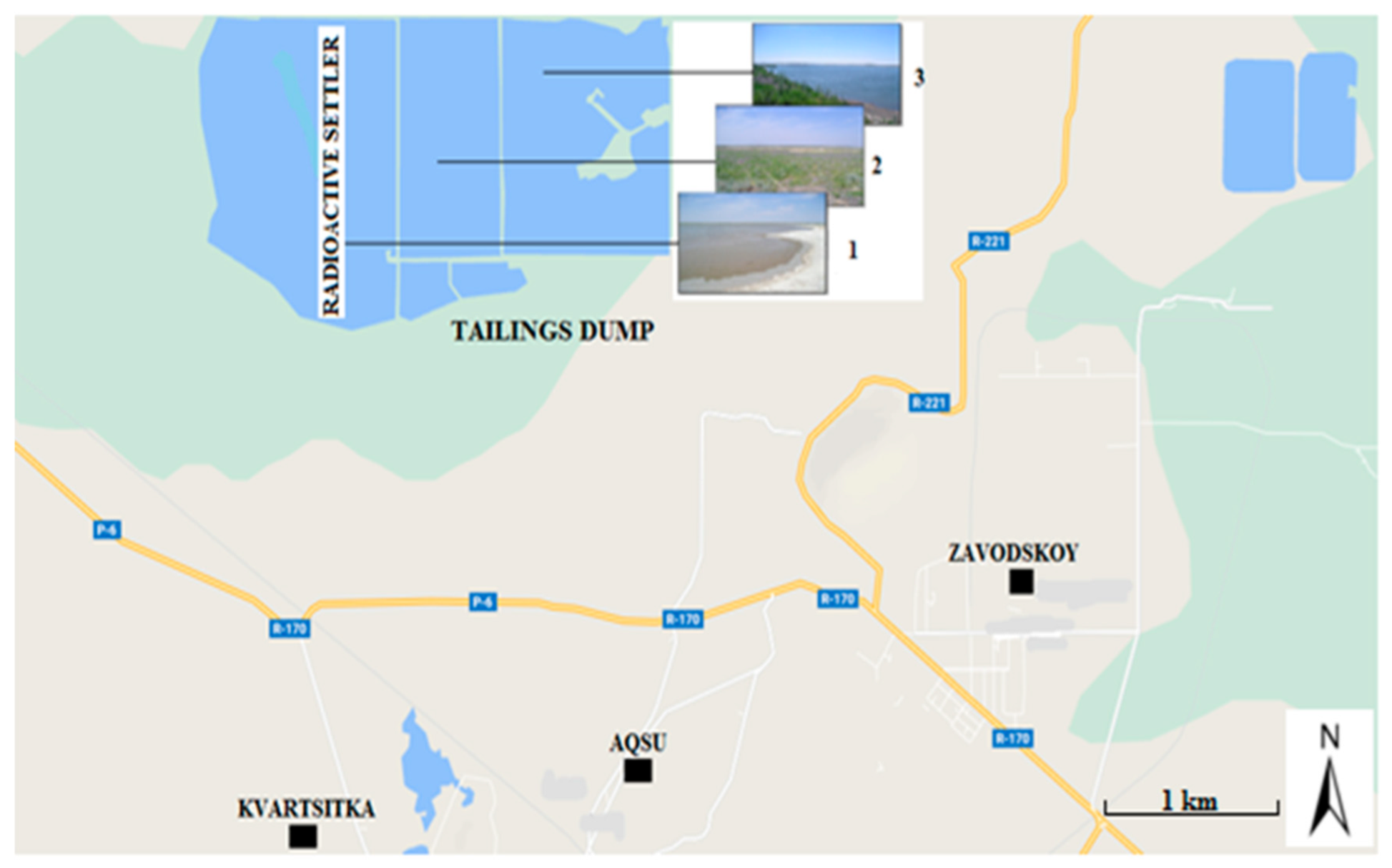
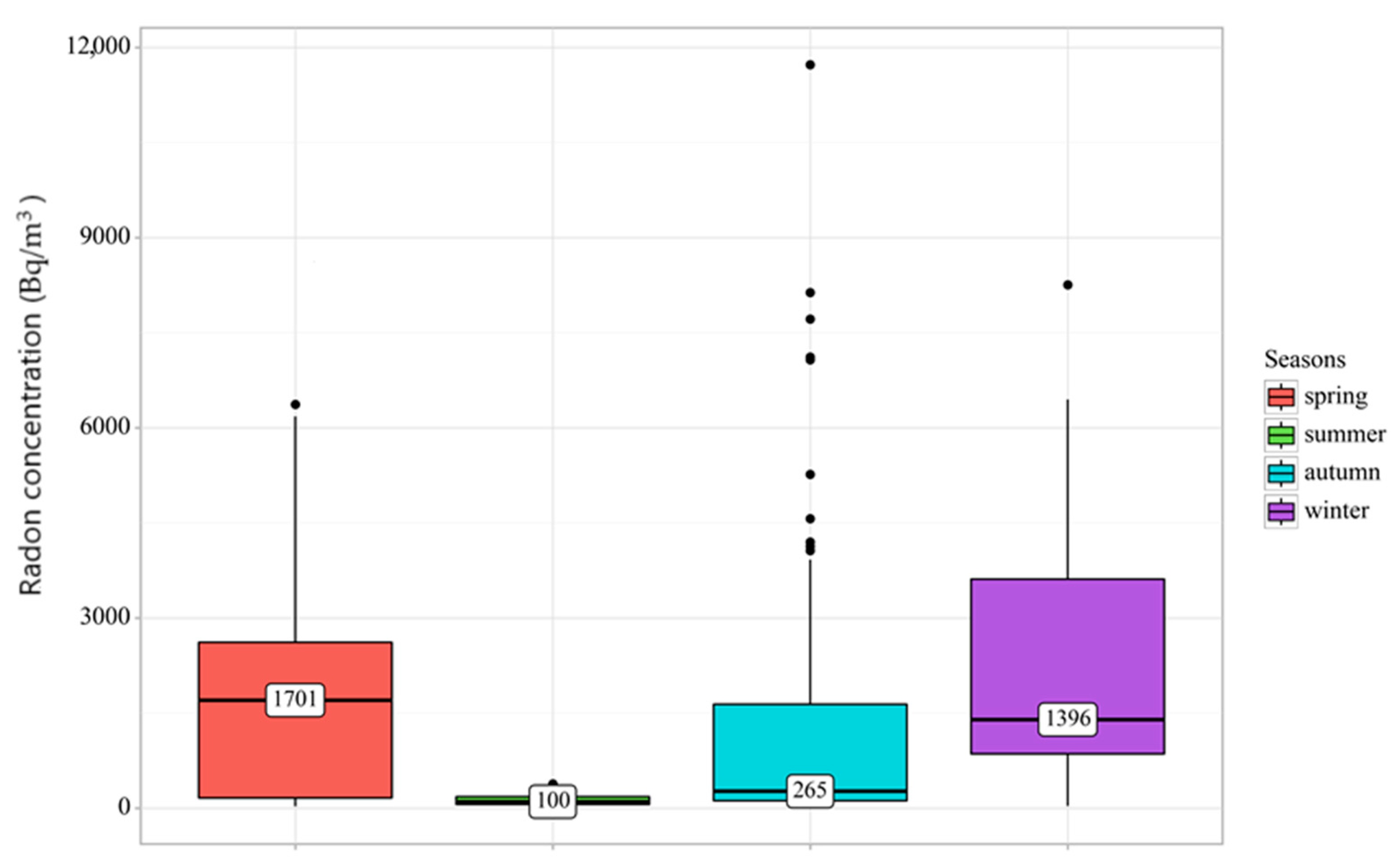

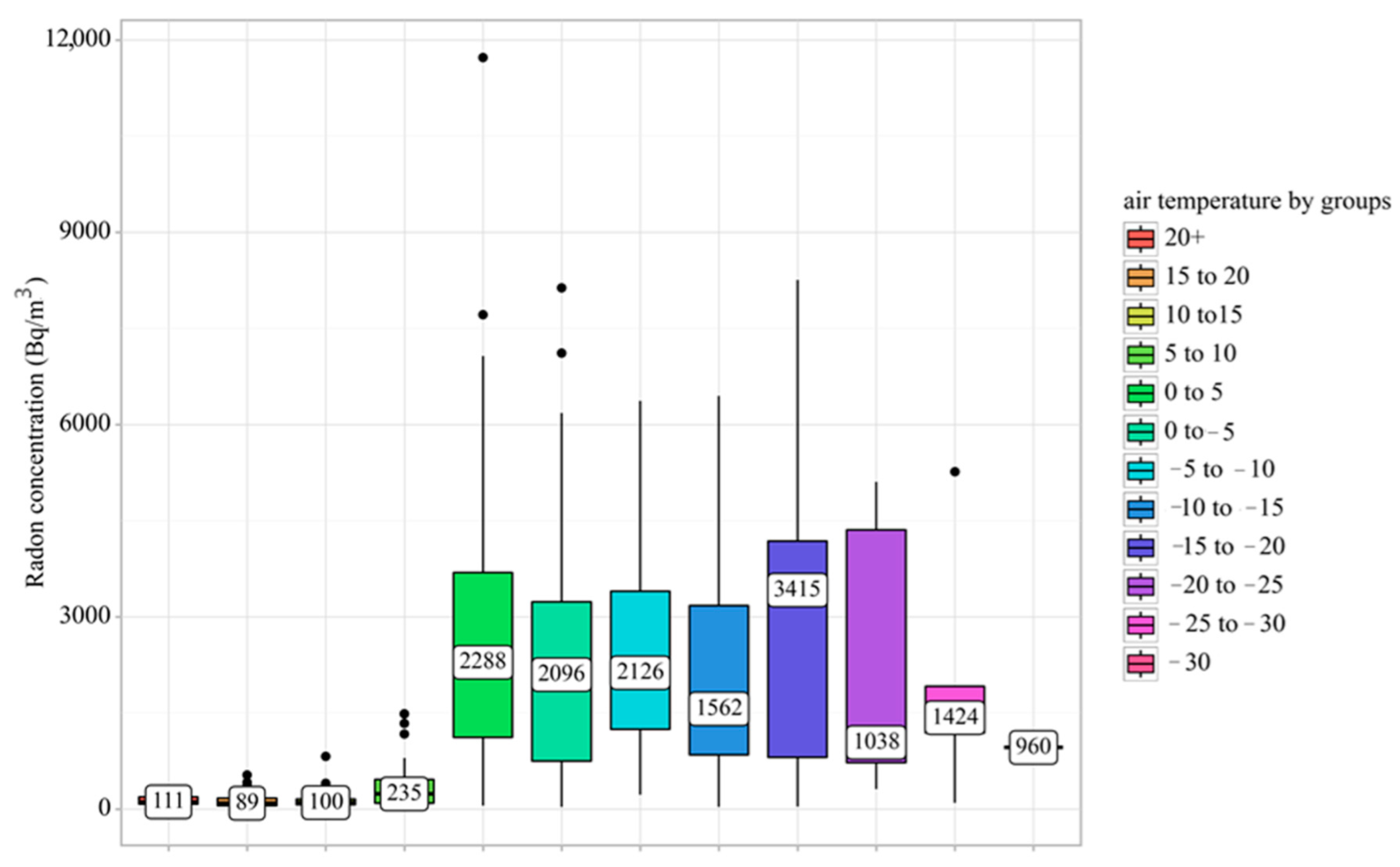
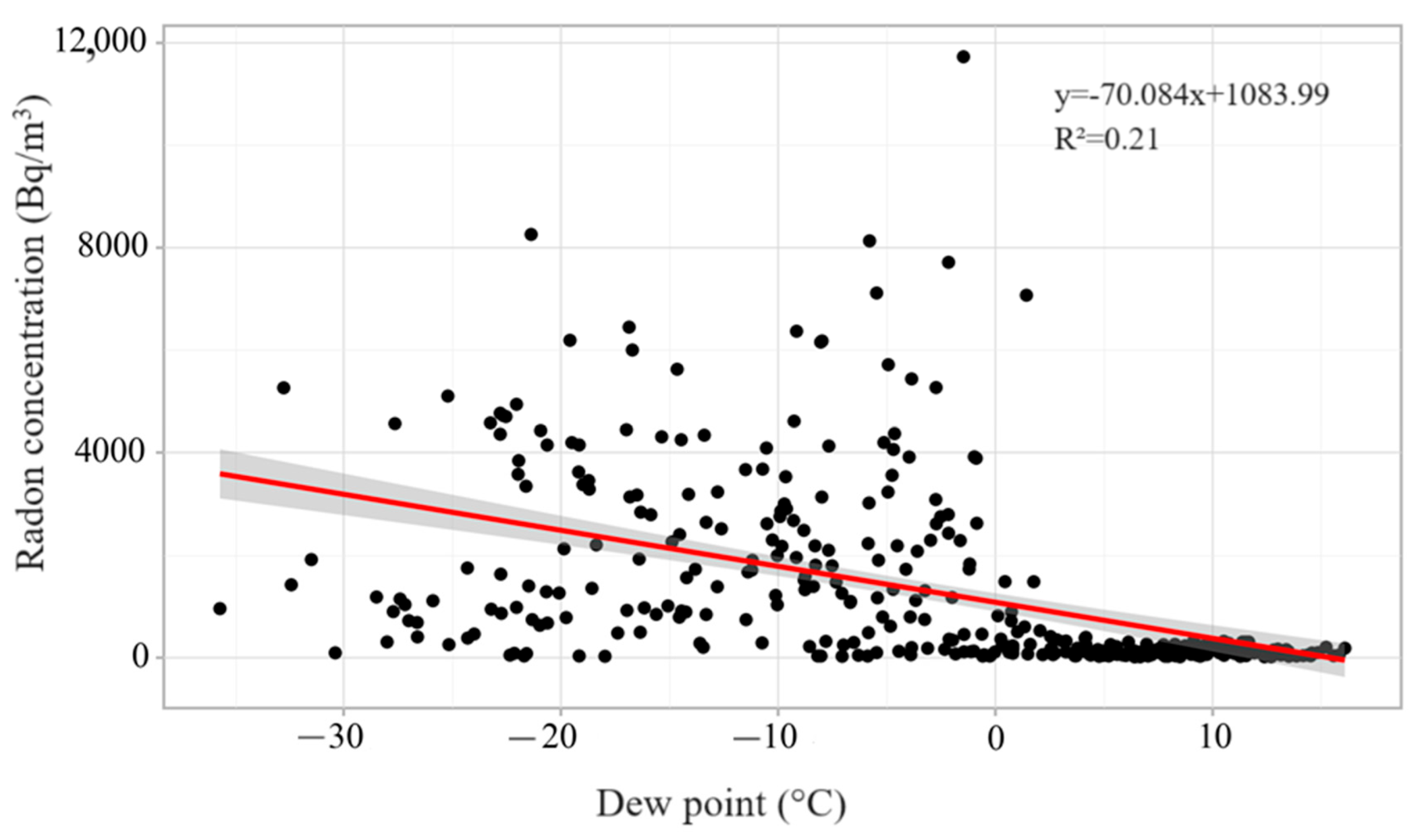
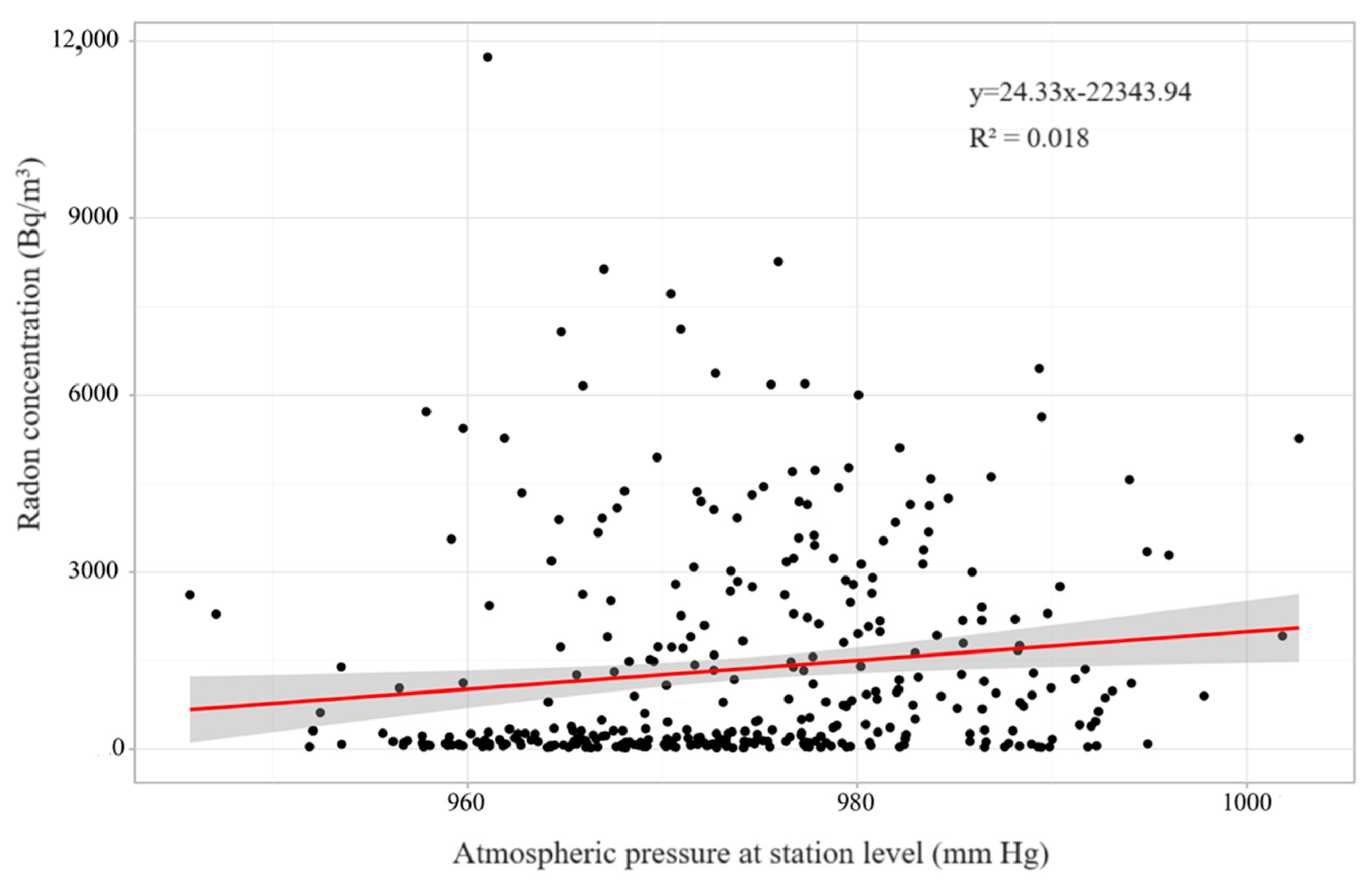
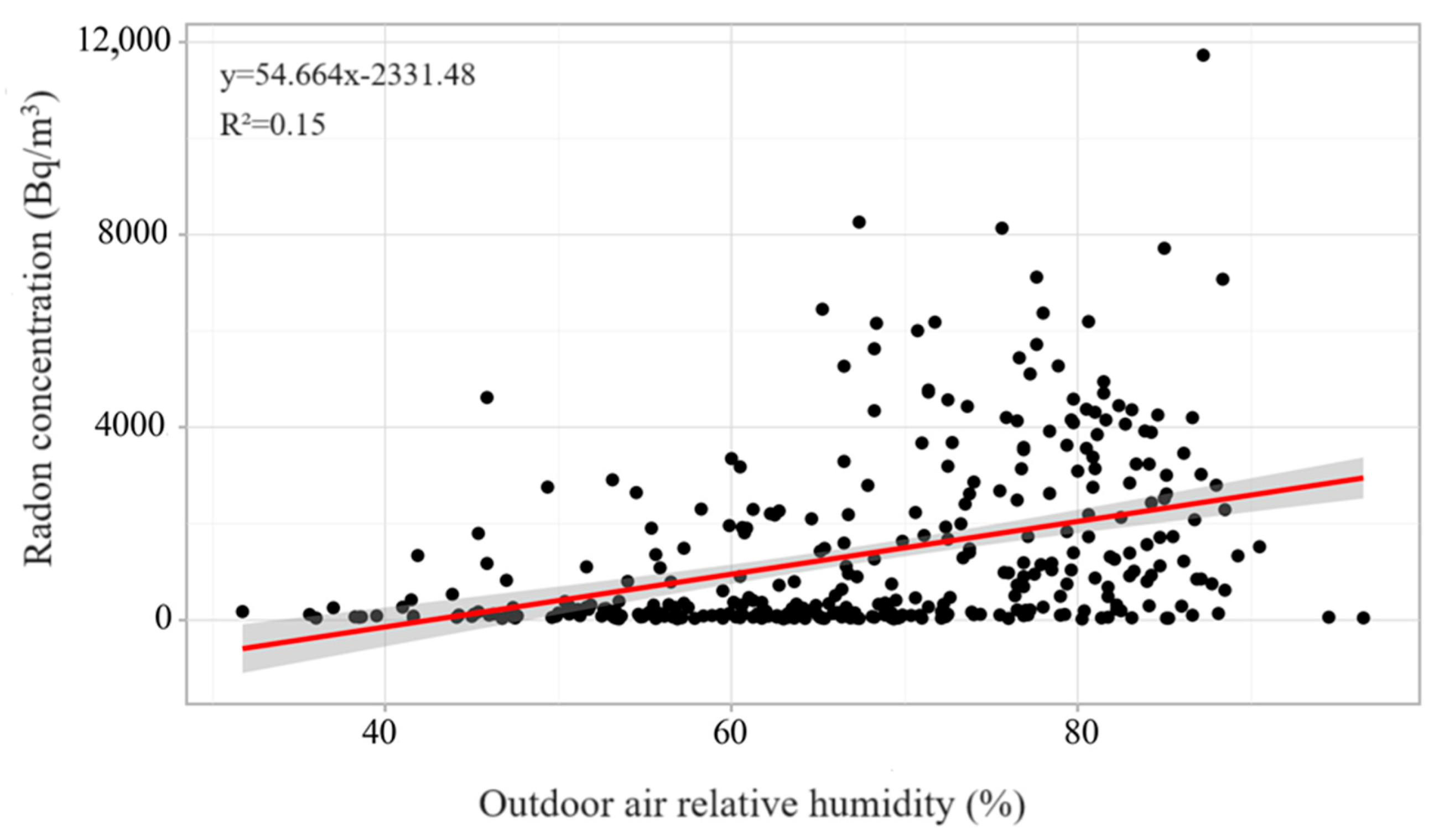
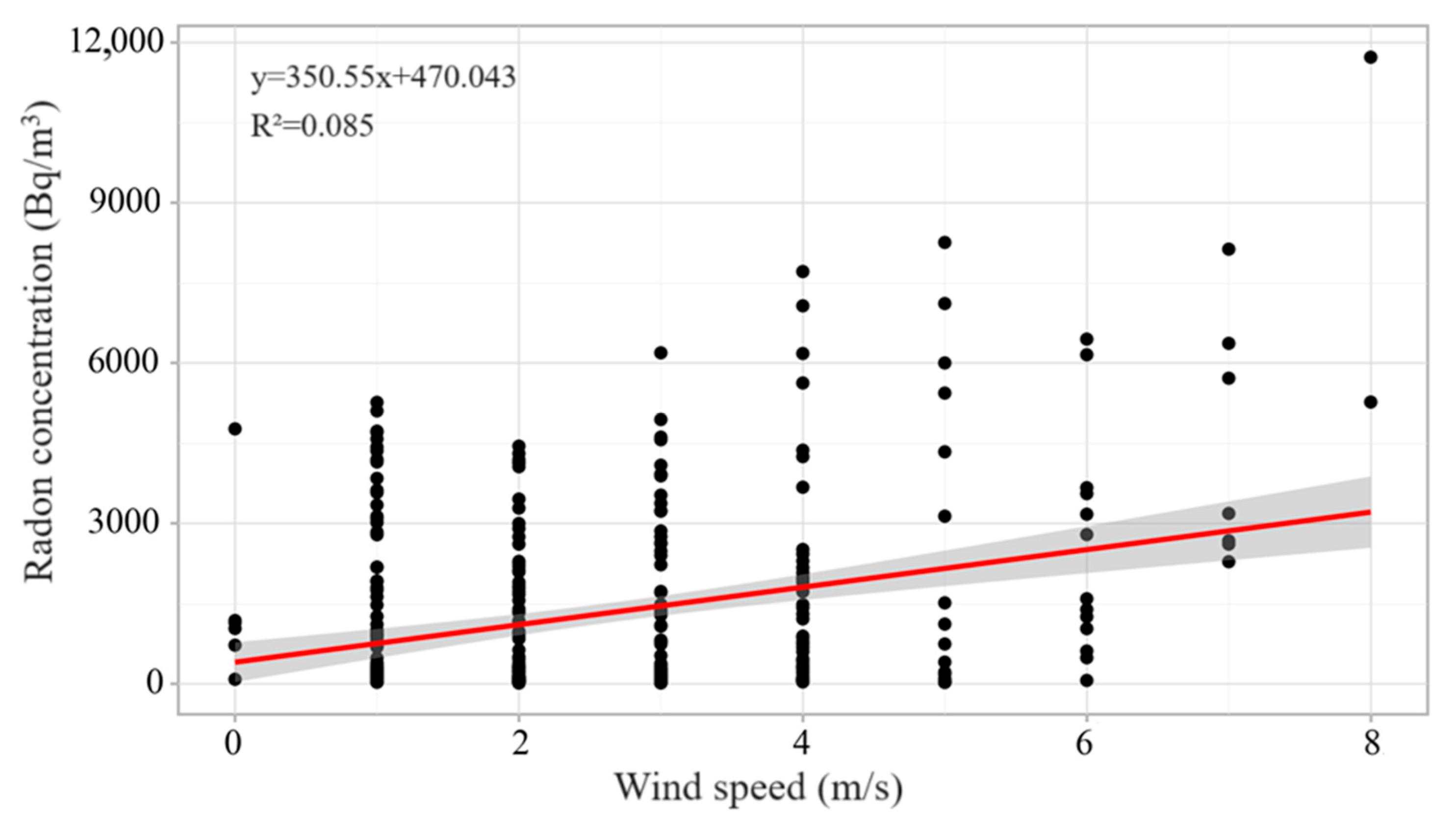
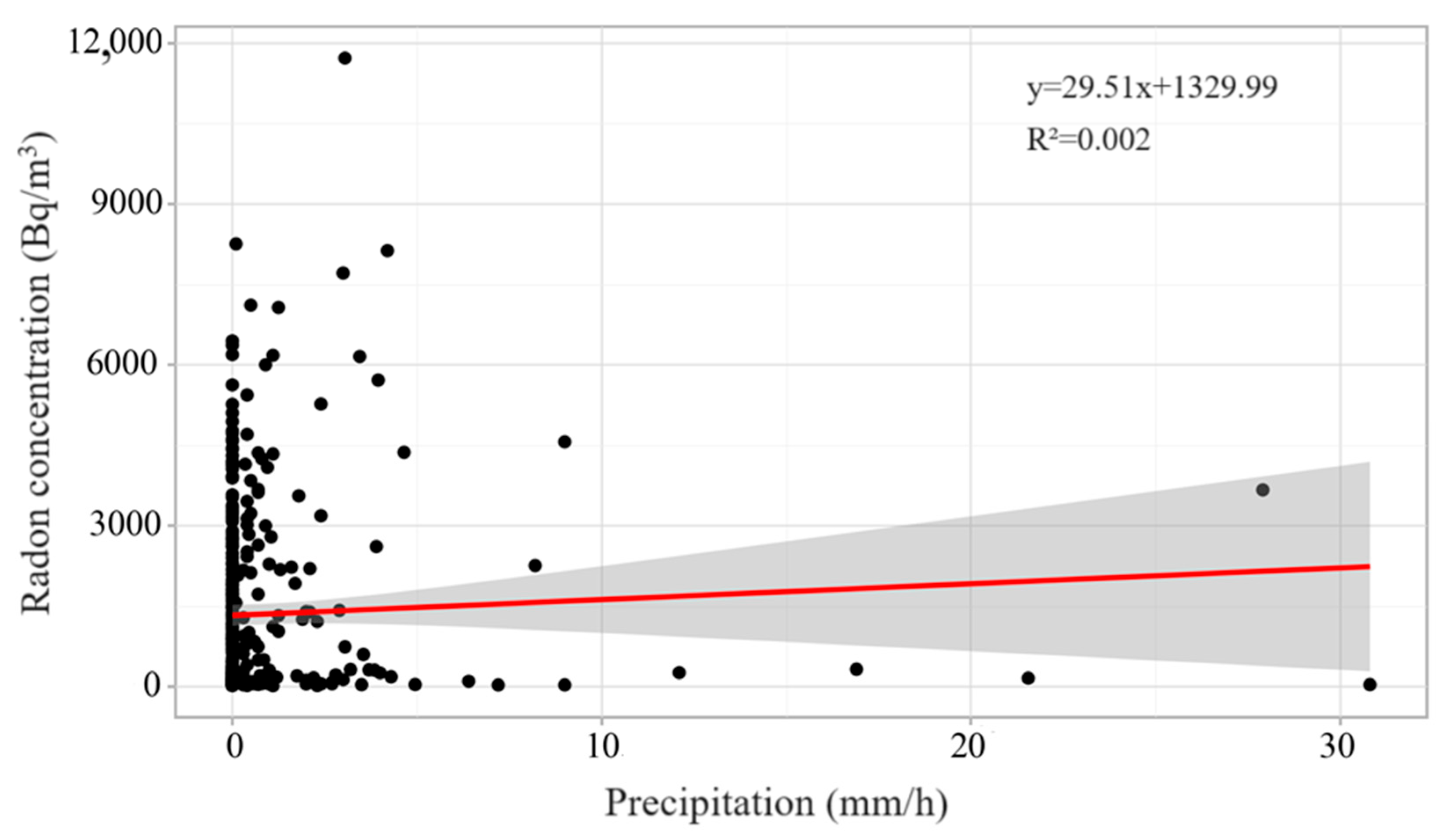
| Variables | M ± SD/Me | 95% CI/Q₁–Q₃ | n |
|---|---|---|---|
| Air temperature, Me (°C) | 2 | −9–16 | 353 |
| dew point, Me (°C) | −2 | −13–6 | 353 |
| soil surface temperature, Me (°C) | 1.9 | −9.9–19.4 | 353 |
| atmospheric pressure at station level, M ± SD (mm Hg) | 974 ± 10 | 973–975 | 353 |
| atmospheric pressure at sea level, Me (mm Hg) | 1020 | 1011–1029 | 353 |
| the magnitude of the barric trend, Me (hPa) | 1 | 0–1 | 353 |
| wind speed, Me (м/s) | 2 | 2–3 | 353 |
| precipitation1, Me | 0 | 0–0 | 353 |
| air humidity, Me (%) | 68 | 57–78 | 353 |
| radon concentration, Me (Bq/m3) | 364 | 99–2096 | 353 |
| Place of Measurement | The Results of Radon Concentration, Bq/m3 | ||
|---|---|---|---|
| Before Turning on the Ventilation System | 30 min after Turning on the Ventilation System | 60 min after the Ventilation System Is Turned on | |
| 1st floor | 552 ± 184 | 255 ± 85 | 44 ± 13 |
| Bedroom No. 1 (children’s garden) | 683 ± 223 | 433 ± 144 | 153 ± 51 |
| Gym | 491 ± 158 | 335 ± 107 | 85 ± 27 |
| Canteen | 489 ± 152 | 120 ± 38 | 106 ± 35 |
| 3rd floor, № 32 | 531 ± 177 | 146 ± 44 | - |
| 3rd floor, № 34 | 225 ± 71 | 64 ± 21 | - |
| 3rd floor, № 36 | 388 ± 127 | 42 ± 14 | - |
| 2nd floor, № 21 | 220 ± 69 | 174 ± 55 | - |
| 2nd floor, № 26 | 132 ± 41 | - | - |
| 2nd floor, № 22 | 457 ± 147 | 172 ± 49 | - |
| 2nd floor, № 24 | 158 ± 47 | 15 ± 4 | - |
| B | Std Error | t | P | R2 | |
|---|---|---|---|---|---|
| Intercept | −2065 | 427 | −5 | <0.001 * | 0.36 |
| dew point | −61 | 7 | −9 | <0.001 * | |
| wind speed | 336 | 52 | 6 | <0.001 * | |
| air humidity | 34 | 6 | 5 | <0.001 * |
| Place of Measurement | , L/s Person | ACH, h−1 |
|---|---|---|
| 1st floor | 7 | 4 |
| Bedroom No. 1 (children’s garden) | 6 | 3.3 |
| Gym | 4 | 0.6 |
| Canteen | 5 | 1.6 |
| 3rd floor, № 32 | 7 | 4 |
| 3rd floor, № 34 | 7 | 3.6 |
| 3rd floor, № 36 | 7 | 3.1 |
| 2nd floor, № 21 | 8 | 4 |
| 2nd floor, № 26 | 7 | 3.8 |
| 2nd floor, № 22 | 6 | 3 |
| 2nd floor, № 24 | 8 | 3.3 |
Disclaimer/Publisher’s Note: The statements, opinions and data contained in all publications are solely those of the individual author(s) and contributor(s) and not of MDPI and/or the editor(s). MDPI and/or the editor(s) disclaim responsibility for any injury to people or property resulting from any ideas, methods, instructions or products referred to in the content. |
© 2024 by the authors. Licensee MDPI, Basel, Switzerland. This article is an open access article distributed under the terms and conditions of the Creative Commons Attribution (CC BY) license (https://creativecommons.org/licenses/by/4.0/).
Share and Cite
Kashkinbayev, Y.; Bakhtin, M.; Kazymbet, P.; Lesbek, A.; Kazhiyakhmetova, B.; Hoshi, M.; Altaeva, N.; Omori, Y.; Tokonami, S.; Sato, H.; et al. Influence of Meteorological Parameters on Indoor Radon Concentration Levels in the Aksu School. Atmosphere 2024, 15, 1067. https://doi.org/10.3390/atmos15091067
Kashkinbayev Y, Bakhtin M, Kazymbet P, Lesbek A, Kazhiyakhmetova B, Hoshi M, Altaeva N, Omori Y, Tokonami S, Sato H, et al. Influence of Meteorological Parameters on Indoor Radon Concentration Levels in the Aksu School. Atmosphere. 2024; 15(9):1067. https://doi.org/10.3390/atmos15091067
Chicago/Turabian StyleKashkinbayev, Yerlan, Meirat Bakhtin, Polat Kazymbet, Anel Lesbek, Baglan Kazhiyakhmetova, Masaharu Hoshi, Nursulu Altaeva, Yasutaka Omori, Shinji Tokonami, Hitoshi Sato, and et al. 2024. "Influence of Meteorological Parameters on Indoor Radon Concentration Levels in the Aksu School" Atmosphere 15, no. 9: 1067. https://doi.org/10.3390/atmos15091067
APA StyleKashkinbayev, Y., Bakhtin, M., Kazymbet, P., Lesbek, A., Kazhiyakhmetova, B., Hoshi, M., Altaeva, N., Omori, Y., Tokonami, S., Sato, H., & Ibrayeva, D. (2024). Influence of Meteorological Parameters on Indoor Radon Concentration Levels in the Aksu School. Atmosphere, 15(9), 1067. https://doi.org/10.3390/atmos15091067







